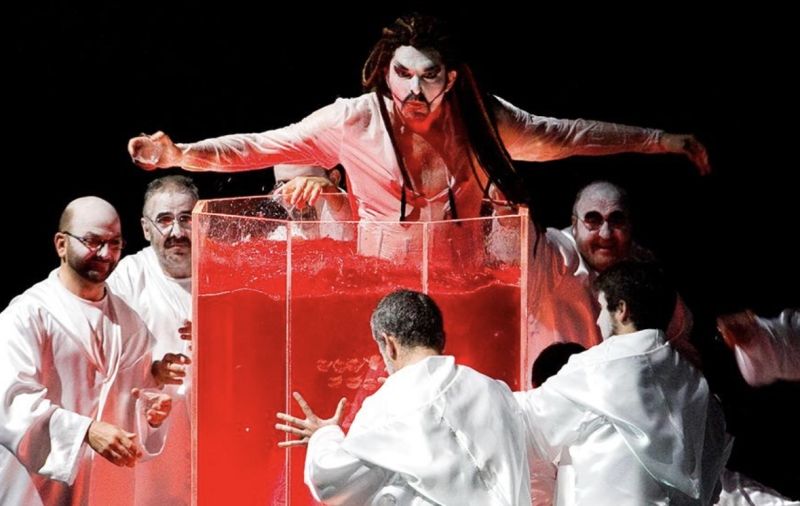
Composer Carl Orff most certainly would never have imagined having his most beloved cantata Carmina Burana staged with costumes , actors, dancers, and scenery. As one of those most popular choral pieces performed worldwide by Symphony Orchestras everywhere, the established tradition is to perform this piece in standard oratorio fashion.
In an attempt to revive an opera program at Artpark in Lewiston, the artistic staff has programmed a staged production of Carmina Burana that is one for the history books. Barcelona’s La Fura Dels Baus has brought their production to Western New York for it’s North American premiere in what can best be described as an intriguing avant garde theatrical event to tempt the senses.
This unusual piece is an audience favorite, with it’s eclectic amalgamation of languages and musical styles. Divided into three parts, “Spring,” “In the Tavern,” and “Courtly Love,” the various texts are based on 12th and 13th century poems and Gregorian chants. Orff places his own unique musical style to the texts, with clear influences of Stravinsky. Although there is no single story being told, Director and Stage Designer Carlus Padrissa dives into the piece with fascinating attempts at visual imagery to complement the rhythms and text. The visuals are edgy and often other worldly, with futuristic touches that defy any specific time period.
Engaging an ensemble of spritely young women costumed in white robes and white makeup, this bevy offers interpretive dance and gesticulations to suggest everything from water nymphs to young maidens in love.
Using an enormous ellipse shaped sort of tent made of scrims, the lighting and some fascinating projections allow waterfalls, cascading flowers and live action video streaming to dazzle the audience. Add to that a massive water tank and an enormous hydraulic arm and the possibilities for staging are endless. Members of the troupe often spill into the auditorium, even supplying mists of flower scents from atomizers throughout the audience. The overall experience became one that stimulated sight,sound and smell, while challenging the audience at times to make sense of the cacophony.

The well prepared Buffalo Philharmonic Chorus, under the direction of Adam Luebke , is divided evenly on either side of the stage, each flanked by grand pianos.
Conductor Gil Rose did an admirable job with the huge forces involved, including a lovely children’s chorus and the large Buffalo Philharmonic Orchestra in the pit. Despite a few issues with the two sides of the chorus being in synch, their overall sound was lovely, if slightly overpowered during the opening infamous chorus “O, Fortuna.” The percussion was crisp and added excitement with it’s many colors and syncopation. Meanwhile the brass shone in the largest passages.
The four soloists were game for all of the staging challenges. Countertenor Jordi Domenech Subirans was raised high in the air and twisted in circles as the dying swan being roasted on a spit. Baritone Antoni Marsol and soprano Luca Espinosa Gil sported revealing body suits as they swam in the large water tank, doing a seductive underwater dance. Soprano Amparo Navarro Serra was hoisted high above the stage , beginning with a not so sweetly sung “Dulcissime,” but settling in to a loving sung lullaby as if a beckoning angel. The chorus sings of the lovers Blanziflor and Helena and the work ultimately ends with a reprise of “O, Fortuna” and the mysteries of life’s spinning wheel of fortune.
Supertitles would have been appreciated to help the audience with some of the oddities of the text, especially given this new, often space age staging.
Nearly a half century ago, opera flourished at Artpark, under the direction if Christopher Keene, bringing the North American premiere of Philip Glass' "Satiagraha" in 1981 and the famed four-year staging of Wagner's "Ring Cycle" in 1984-88. Later in the 1990’s, The Greater Buffalo Opera Company paired with Philadelphia’s Academy of Vocal Arts to present glorious productions of standards including La Boheme, Madama Butterfly, and La Traviata. Judging by this sold out production of Carmina Burana, (although not truly an opera), audiences are primed to see a return of summer opera offerings.
Contact Artpark.net for further information regarding future programming.
Reader Reviews

Videos

